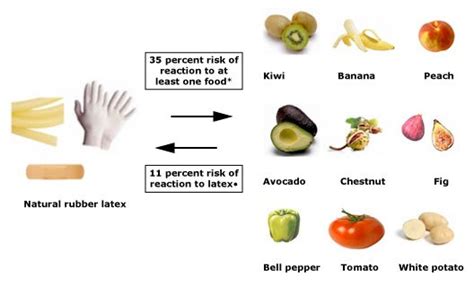what foods are risk factory for latex ,foods that cause latex allergy,what foods are risk factory for latex,Natural rubber latex contains proteins that can trigger an allergic reaction. Some food contains similar proteins and can cause what is known as latex-fruit reactions. As the name suggests, . Reddit's go-to source for news and discussion about Rolex and Tudor watches. . due to an elevated debt to credit ratio. Unless you use Amex anyways, since Amex doesn’t report your statement balance. Reply reply More replies. . If you buy a $40,000 Rolex and just use a Capital One Quicksilver Card you save $600.

Introduction:
Latex allergy is a common allergic reaction to proteins found in natural rubber latex. For individuals with latex allergy, exposure to certain foods can also trigger allergic reactions due to cross-reactivity between latex proteins and proteins found in these foods. This phenomenon is known as latex-fruit syndrome, where individuals allergic to latex may also experience allergic reactions to certain fruits and vegetables. In this article, we will explore the foods that are risk factors for latex allergy, as well as common food allergens associated with latex allergy.
Foods that Cause Latex Allergy:
1. Bananas: Bananas are one of the most common fruits associated with latex allergy. The proteins in bananas are similar to those found in latex, leading to cross-reactivity in individuals with latex allergy. Symptoms of banana allergy in latex-sensitive individuals may include itching, swelling, and hives.
2. Avocado: Avocado is another fruit that can trigger allergic reactions in individuals with latex allergy. The proteins in avocado share similarities with latex proteins, making it a risk factor for cross-reactivity. Symptoms of avocado allergy in latex-sensitive individuals may include oral itching, swelling, and gastrointestinal discomfort.
3. Kiwi: Kiwi is known to cause allergic reactions in individuals with latex allergy due to cross-reactivity between kiwi proteins and latex proteins. Symptoms of kiwi allergy in latex-sensitive individuals may include oral itching, hives, and swelling of the lips and tongue.
4. Chestnuts: Chestnuts are tree nuts that have been reported to trigger allergic reactions in individuals with latex allergy. Cross-reactivity between chestnut proteins and latex proteins can lead to symptoms such as itching, hives, and respiratory issues in latex-sensitive individuals.
5. Papaya: Papaya is another fruit that can cause allergic reactions in individuals with latex allergy. The proteins in papaya are similar to those found in latex, leading to cross-reactivity and potential allergic symptoms such as itching, swelling, and gastrointestinal discomfort.
Food Allergy to Latex:
Individuals with latex allergy may also experience allergic reactions to certain foods due to cross-reactivity with latex proteins. This phenomenon, known as latex-fruit syndrome, can result in allergic symptoms when consuming certain fruits, vegetables, and nuts. Common food allergens associated with latex allergy include bananas, avocados, kiwi, chestnuts, and papaya, among others.
Latex Allergy Foods Examples:
1. Strawberries: While not as commonly associated with latex allergy as other fruits, strawberries have been reported to cause allergic reactions in some individuals with latex allergy. Cross-reactivity between strawberry proteins and latex proteins can trigger symptoms such as itching, hives, and swelling in latex-sensitive individuals.
2. Mango: Mango is another fruit that may cause allergic reactions in individuals with latex allergy. The proteins in mango share similarities with latex proteins, leading to cross-reactivity and potential allergic symptoms in latex-sensitive individuals.
3. Tomatoes: Tomatoes have also been reported to trigger allergic reactions in individuals with latex allergy. Cross-reactivity between tomato proteins and latex proteins can result in symptoms such as oral itching, hives, and gastrointestinal discomfort in latex-sensitive individuals.
4. Peaches: Peaches are known to cause allergic reactions in some individuals with latex allergy. The proteins in peaches can cross-react with latex proteins, leading to symptoms such as itching, swelling, and hives in latex-sensitive individuals.
5. Celery: Celery is a vegetable that can also trigger allergic reactions in individuals with latex allergy. Cross-reactivity between celery proteins and latex proteins may result in symptoms such as oral itching, hives, and gastrointestinal discomfort in latex-sensitive individuals.
Foods Similar to Latex:
In addition to fruits, vegetables, and nuts that are known to cause allergic reactions in individuals with latex allergy, there are other foods that share similarities with latex proteins and may also trigger allergic responses. Foods similar to latex include certain spices, such as ginger, and certain seeds, such as sunflower seeds and poppy seeds. Individuals with latex allergy should be cautious when consuming these foods, as they may lead to cross-reactivity and allergic symptoms.
Latex Fruit Syndrome Foods:
Latex-fruit syndrome refers to the phenomenon where individuals allergic to latex may also experience allergic reactions to certain fruits and vegetables due to cross-reactivity with latex proteins. Common foods associated with latex-fruit syndrome include bananas, avocados, kiwi, chestnuts, papaya, strawberries, mango, tomatoes, peaches, and celery, among others. Individuals with latex allergy should be aware of potential cross-reactivity with these foods and monitor their intake to prevent allergic reactions.

what foods are risk factory for latex Enjoy a unique experience at one of our elegant Rolex Certified Pre-Owned showrooms, beautifully designed to exhibit a large selection of timepieces, including Rolex’s most iconic models.
what foods are risk factory for latex - foods that cause latex allergy